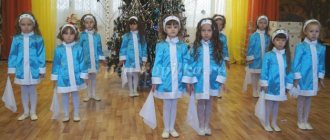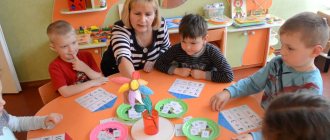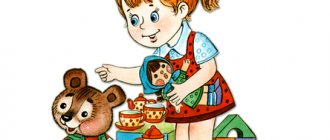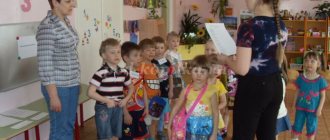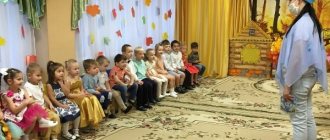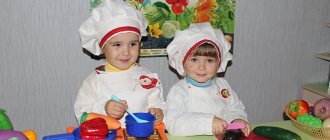Dance games for kids
Zhanna Gorbatenko
Dance games for kids
Dance games for kids
Children love to make things up. In order for them to express and express themselves, they need to be given as much independent time as possible to invent and implement their ideas. Even if you are Maya Plisetskaya or Nikolai Baryshnikov, the task of the lesson leader is only to direct the child’s imagination and impulse, and not to impose your own on him. Your experience will be dead for children . Therefore, encourage their imagination and allocate “independent time” to implement their ideas. It will be much better if you suggest dance techniques and movements to children on “their territory”, when creating dances . Even if at first these dances may seem bad to you, uninteresting, full of ostentatious “coolness”
.
Give children the opportunity to get over this. (They usually bring something like “Hands Up”
or
“Red Mold”
dances ). Don't discourage them. Be patient. Over time, if they are constantly shown how they can do BETTER, children will want to try something else.
1. Completing the figures
Children are divided into two teams. Each team is asked to build its own composition-figure as follows: one person comes out of the line and takes some pose that he thinks is beautiful. (Invite him to close his eyes and take the body position that his momentary mood, music and inspiration dictates). The next person in line approaches him and tries to “complete” the composition by taking some kind of complementary position next to the first person. It can touch the first one, it can stand close or far away from it, the main thing is that they create an overall composition that fills the space.
Then a third person “adjusts” to them, a fourth, and so on - until the very last participant. As a result, each team should have a beautiful multi-armed, multi-legged figure.
Teams can play simultaneously or take turns, watching each other’s successes from the perspective of spectators.
2. Garden
Each child is offered his own task - to dance some animal , plant or part of the landscape. To create some images (say, a stream or a cloud)
Children can unite in groups of several people.
You can come up with cards yourself, but here are a few examples: Bee, chamomile, apple tree, rose bush, lily, grasshopper, rabbit, kitten, sun, stream, cherry, lilac bush, sparrow, swallow, cloud, etc.
After this dance, invite the children to complicate the task - to dance together one common Garden. To do this, you need to explain to them what a common, group dance is, that the overall picture greatly depends on the efforts of everyone.
Then there is a gradual integration of images into the overall picture of the dance . That is, one group of people , say, trees, begins to dance. Then animals and flowers join them... And so on until the last participant.
3. Dance of nature
All children are divided into pairs and triplets (if desired, larger groups, and then, to the same music, the groups each prepare their own dance on a common theme. (for example, dance of the sunrise, sea surf, clouds, stars, fire, fountain) .
It’s good that you take the time to watch not only the “process”
of each group of children dancing , but also arrange a general “view”
of what happened. Have all the children sit in one part of the room, like in an auditorium, and then each team takes turns showing their dance.
4. Brook
The children hold hands, and then everyone except the first in the line closes their eyes. The task of each person in the line is to repeat and pass on the movements of the first to the next. If the first one raises his hand, then the second one should also raise his hand, transferring the movement to the third one. So - until the very last person in the line. The result should be a real trickle of movements.
Then it will be possible to begin to convey movements with steps and movement of the entire stream. After several specified movements, the first person changes, going to the end of the line, and the one next to him becomes the leader.
5. “Bird in a Cage”
All children join hands and form a circle - a “cage”. Someone alone remains in the center. He becomes a Bird in a Cage. He needs to dance his dance so that the cage will release him. A circle of children can play along with the Bird, raising and lowering their hands, sometimes opening a way out. The task of the cage is not to prevent the Bird from escaping, but, on the contrary, to help. But the dance must also be worthy of Freedom!
6. The ball is invisible
Children stand at a distance opposite each other or in a circle. The game is that everyone throws or passes a non-existent ball to each other. We need to help children feel this ball in their hands. It should not be small or large, curved, light or heavy. You can invite children to rub their palm against their palm for a minute, and then slowly move them apart - a feeling of connection between the palms arises. This relationship needs to be extended to the size and shape of the ball.
When this stage is passed, you can try to shape, feel in your hands and transfer other objects - a jug, tray, fabric, flowers... They can be transferred along with some dance movement .
7. Mirror
The children are divided into pairs and sit opposite each other. One of them slowly begins to set movements to the music. The other becomes a “mirror”, and its task is to accurately reflect all the movements of the person asking. He must renounce himself so much and feel like a reflection that from the outside it is impossible to distinguish who sets the movements and who repeats them. Then the children change roles.
8. Who am I?
The host of the game pre-prepares a series of cards with simple concepts for everyone. (For example: fairy tale, sea, wolf, Baba Yaga, book, star, fox, swan, gnome, etc.)
Children sit in a circle. The presenter gives one of them a card so that others cannot spy. The child goes into a circle. His task is to dance the image given to him . Explain to the children that for this you need to very, very much transform into your image and dance it as if “from the inside.” It is useless to show with your hands the horns of a deer or the mouth of a crocodile; you need to convey with your plasticity and posture, facial expressions and movements - what the deer and crocodile feel, and then everyone will be able to guess who you are!
By giving a child a minute or two to dance , other children may begin to guess who he was. When the image is guessed, the first person gives way to the next one in the circle.
9. Unravel the string
This is a pretty fun game, so get ready for some noise and laughter! It is best played by a small number of people or several teams.
Children stand in a circle, hold hands and begin to get confused. They can twist, step over each other's arms and legs, sit down, lie down, lift each other in their arms, and so on. The result is a completely unraveling tangle of children .
The presenter turns on the music and sets the speed or pace for the participants to unravel. He says: “Now you must unravel at the speed of a sea wave” or “Like a tropical cactus.” task to unravel their rope while dancing
10. Dance situation
game leader prepares cards with situations that will need to be acted out in dance . Children are divided into teams of two to five people and receive their card. After which the music is played and the teams are given time to prepare. task is to assign roles , prepare and show a dance-situation in front of everyone, like a small scene.
Spectators watch who got what, and then try to guess and retell what exactly they think played out.
Example cards: Priestess makes a fire in the Temple, Girl collects flowers in the forest, Traveler climbs a mountain, Fire, etc.
11. Dance of Fire
All players sit in a circle. They represent Fire and their common task is to dance the Bonfire Dance . Each person can have their own movements, or they can be “set” by one person, or best of all, by each of the dancers in turn . This is preliminary preparation for the game, after which children can be asked to complicate it.
The whole circle becomes simply travelers who are relaxing by the Bonfire (savages or pirates, and only one of the dancers remains in the center and dances Bonfire . He has the right to move in all directions like tongues of flame. Travelers try to prevent the Bonfire from burning them. (At the same time the movements of those sitting around the Fire must remain synchronized.)
12. Dance without music
Everyone stands in a circle, one person goes to the center. Children must invent and create an atmosphere of dance . For example – rain, fire or gust of wind. (The circle can clap, click, stomp, blow, hum, howl, spin, jump, etc. in a certain rhythm.)
The task of the one who remains in the circle is to feel and convey in the dance the state of space that is given to him.
There is another version of the same game : children choose one person and then come up with a Dream for him (fairy-tale circumstances in which he finds himself. In this Dream, each dancer can play his role, or everyone can dance together .) The player’s task is with his dance, without preparation, to react to the circumstances in which he found himself. He can interact with the characters of the Dream or even direct them, the main thing is that the atmosphere of the Dream is “picked up” and conveyed correctly.
13. The Tale of Rodnichka
Each child is given a card with a role (one of the characters in the fairy tale)
as well as time to prepare your
dance . After this, all the children sit in one part of the hall, and the other becomes the hall. The host of the game begins to read the fairy tale, calling those children whose roles appear in the action to dance. Thus, a common fairy tale in dancing .
Example of a fairy tale:
“One early morning the SUN came out and illuminated the DESERT. In this desert there were many, many FLOWERS, CACTi AND PALM TREES. There lived a BUTTERFLY. She was very hot and thirsty all the time. Then the butterfly went in search of water. At this time, a CLOUD was flying across the sky. And the butterfly asked her to make it rain. The cloud agreed and many, many droplets flew to the ground...
But suddenly the WIND blew! He blew away the rain further and the butterfly could not drink. And a SNAKE appeared ahead! The butterfly asked her where to fly and the snake showed her the way. After a while, the butterfly saw real green TREES and BRUBS! And among them flowed a clear and young stream.
The butterfly got drunk and everything ended well!
Cards: Sun, Desert, Flower, Cactus, Palm Tree, Butterfly, Cloud, a few Droplets, Wind, Snake, Tree, Bush, Stream.
Don't be afraid to come up with such tales yourself!
14. Dance skit
All players are divided into pairs, after which each pair is given a card with images for each of them. Children assign roles and come up with a small dance scene where their characters meet and act out some kind of plot. After this, the prepared dances are shown in front of everyone.
Cards: Man and Dragon, Cockroaches, Joyful Elephant and Butterfly, Bird and Cat, Two Hares Playing, Octopus and Fish, Penguin and Seagull, Spider and Predatory Flower, Stump and Young Borer, Puppy and Experienced Dog, Swans, Fallow Deer and Pig, Rooster and hen, Fly and cow, Horse and sheep,
Children's dancing in kindergarten
Most adults believe that dancing is a waste of time. Especially if their child will dance in kindergarten and not study additional mathematics. Are they right? The answer is clear - no.
Dancing is a most interesting and enjoyable activity. Through children's dances in kindergarten, a huge number of tasks related to the development of fine and gross motor skills, ear for music, flexibility and smoothness of movements, skills to work in pairs, in a team, discipline, creativity, intelligence and memory are solved. And most importantly, dancing gives the child the opportunity to have a good time.
Children's dancing in kindergarten puts the right stress on the heart, perfectly trains all muscle groups, joints, vestibular apparatus, and forms correct posture.
But it is worth remembering that it is recommended to start dancing from the age of three. We must understand that in preschool age the foundations of personal, mental and physical development begin to form and be laid. In this type of activity, children memorize dance compositions, learn to interact with each other, improvise and navigate correctly in space.
The teacher, conducting dances in kindergarten, introduces children to the cultural heritage of his country through folk dances. In addition, children love to perform rhythmic movements to modern music, one of the genres is hip-hop. And it doesn’t matter whether the child moves correctly or not, the most important thing is to express yourself through performing movements to the music.
The teacher, when organizing classes, should not keep the child within certain limits; he is obliged to give only a positive assessment of his actions.
At 4–5 years old, children learn simple movements and simple dance compositions. At 6–7 years old, they master more complex movements using props. Children demonstrate their talents at holidays and entertainment events. Parents are amazed by the performances of little dancers. Showing your skills and talent in front of a large audience allows you to get rid of stiffness and feelings of fear, which will undoubtedly come in handy in the future.
Elements of choreography are used in theatrical productions for a more open and vivid development of the plot.
Psychologists have long proven the fact that children who engage in this type of activity are ahead of their peers in development, are successful in their studies, and better develop mathematical and logical concepts, speech, and the ability to quickly navigate in space.
Children's dance helps develop such personality qualities as: hard work, determination, organization. Children who are withdrawn become sociable and relaxed. This type of activity can even help solve some psychological problems, which is why very often mentally retarded children are enrolled in special dance clubs.
As you can see, children's dances in kindergarten bring great benefits for the harmonious and comprehensive development of the child and help him easily make the transition from the position of a preschooler to the position of a schoolchild, successfully mastering educational activities.
In addition, dancing gives the child the opportunity to look positively at the problems occurring in our troubled world.
Middle group. Dance with rowan
Girls of the middle group dance with a sprig of rowan. Song “There is a shadow on the path”, lyrics by Elena Blagina.
On the path there is shadow-shadow-shadow, Solar net. Through the tyn, through the fence, a branch bent.
I’ll come running, I’ll gallop, I’ll stand up on my toes! I’ll grab the branch by the braid and get the berries!
Chorus: Berries, berries, rowan berries. Berries, berries, rowan berries.
I’ll sit by the fence, and carefully string a rowan berry onto the silk.
Put on your bitter beads, become smart, branch! On the path there is shadow-shadow-shadow, Solar net.
Senior group. Entrance to the matinee with leaves
The guys in the older group dance to the song “Dance with Autumn.” Song author Tatyana Petrova, arrangement Alexander Zorin, performer Alina Afanasova.
Look at the leaf - it’s burning like a lantern. The leaf wants to dance - He flies in the dance with us!
We put the foot on the toe and knock everything with the heel. We will add smooth gestures, And then we will spin.
The Beauty Queen invited us to dance. She gave me a leaf, traces of autumn everywhere...
Autumn in polka circles with us, Sings a song merrily. Today we will all become friends with our autumn round dance.
Junior group. Dancing with leaves
Kids with leaves. Dance for children of primary preschool age to the composition “Oak leaves, maple leaves.” Performed by Lyayla Khismatullina.
Swing over me, My golden leaf. Oak leaves, maple leaves.
We are sitting behind a leaf, looking from behind a leaf. Oak leaves, maple leaves.
Suddenly a cheerful breeze wants to tear out my leaf. Oak leaves, maple leaves.
We won’t give you the leaflet, it will be useful to us ourselves. Oak leaves, maple leaves!
Preparatory group. Dance "Falling Leaves".
The older the children, the more complex the movements and dances. The preparatory group dances to the song “It’s not easy to rain today.” Author - N. Naydenova, arrangement - Alexander Zorin, vocals - Marina Melnik.
Today the rain is not simple, today the rain is golden! He is not aquatic at all, there is not a single cloud.
Leaf fall, leaf fall! Leaves are spinning, flying, Leaves are flying in the wind, Falling leaves!
Autumn day is so good, How many leaves can you collect! Golden large bouquet - Greetings from autumn to us!
Leaf fall, leaf fall! Leaves are spinning, flying, Leaves are flying in the wind, Falling leaves!
